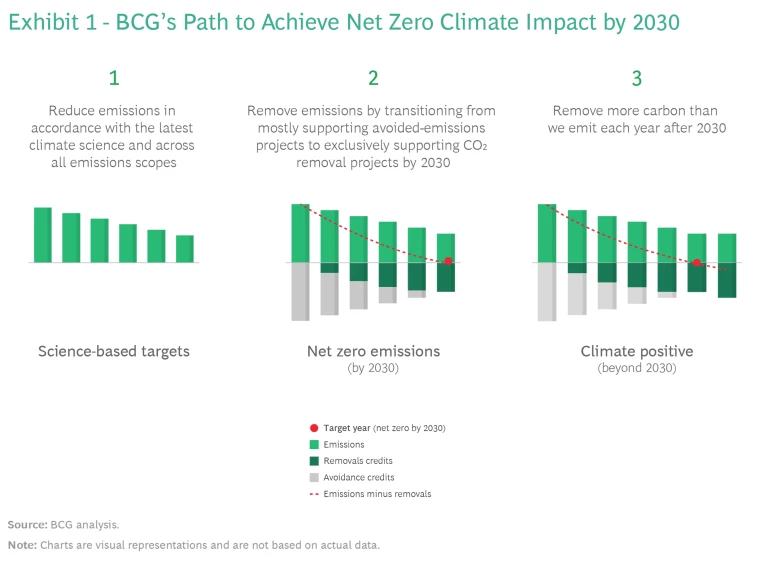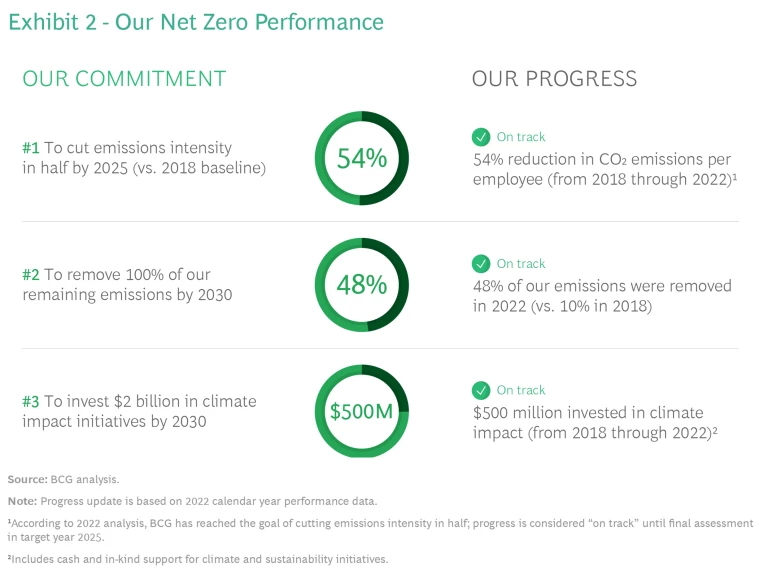In September 2020, BCG committed to a significant goal: achieving net zero climate impact by 2030 and removing more carbon from the atmosphere than we emit each year after that time. (See Exhibit 1.)

Three years into our journey, we’re on track to meet our net zero target. (See Exhibit 2.) At this point, we’ve driven a 54% reduction in emissions per employee (compared to our 2018 baseline), removed 48% of emissions in 2022, and invested more than $500 million in climate impact efforts.
We’ve gained valuable insights during this period—a time of great demand on corporate climate action.

We’ve gained valuable insights during this period—a time of changing, significant, and often hard-to-predict demands on corporate climate action. The effect of the COVID-19 pandemic on operating models, the increased focus on climate within emerging regulation, and the rapid evolution of voluntary standards have created a landscape demanding adaptability.
Moreover, the public’s intensified wariness of greenwashing and the ever-mounting evidence of the immediate impact of the climate crisis have added to the sense of urgency among leading companies to create credible net zero programs that deliver results.
In keeping with BCG’s purpose, to unlock the potential of those who advance the world, we support our clients as they navigate these challenges and move ahead in their net zero progress. At the same time, we strive to lead by example and unlock our own potential as a climate leader. Here are updates on our net zero journey and insights we’ve gathered in its first three years.
Agile Decision Making and Governance
Sound decisions and management structures are essential for effective change, and a net zero transition is no exception—especially in its evolving context. To reduce their climate impact, companies need to adjust quickly to changing standards, regulations, economic conditions, technologies, and more. This requires agile governance that can enable efficient decision making that is tailored to the organization.
For BCG, this has meant adjusting our approach to the net zero goal, optimizing our ability to stay ahead of and respond to changes in critical areas: postpandemic operating models and travel, nascent technologies aimed at removing carbon dioxide, and sustainable aviation fuel (SAF), to name but a few.
To ensure progress, BCG has strengthened the link between the net zero program and the firm’s broader strategy and operations.
As part of this effort, the firm strengthened the link between BCG’s net zero program and its broader strategy and operations by appointing a member of the Operating Committee and the managing director of the North American offices to the role of global chief sustainability officer .
Keeping decision makers informed has also been a key component of responding to the fast-moving environment. To do this, BCG continually engages with expert advisors and delegates decision-making authority within the firm, unlocking new opportunities.
Distributed leadership is also important. “Green teams,” spread across more than 80 BCG offices, focus on designing and implementing initiatives to reduce our environmental impact at the local office level. “Net zero nodes”—senior employees across each region of BCG—develop actions suited to the broader local context, while also transferring knowledge across the firm and helping to quickly scale pilot projects to wider adoption. And a global center of excellence team tackles firm-wide topics, such as carbon credits, reporting, and the use of SAF, and engages with other global functions within BCG to align strategies.
Transparency and Accountability
Our net zero goal is to continue delivering high-value work to clients while reducing emissions. To achieve this, much of our efforts in the past three years has focused on increasing our accountability and transparency regarding our emissions.
To address our largest emissions source, business travel, we aligned our responsibilities for carbon budgets with our financial budgets and provided performance indicators. This ensures consistency between broader business planning and emissions reduction planning, and enables deeper emissions awareness in core strategy and operations.
We also developed new tools for better carbon management, providing greater transparency of emissions performance at the business, case team, and individual levels. Leaders have access to dashboards that showcase the performance of their specific regions and business units, so they can compare their progress to historical trends and monitor performance against targets. Versions of these dashboards are also in place for case team and functional leaders, helping to unlock emissions reductions at all levels.
Complementing these transparency tools are a suite of planning tools. For example, our case emissions calculator enables case leaders to quickly identify the most carbon-intensive cases and model different scenarios that will have less environmental impact. Our meeting location optimizer tool enables large-event planners to identify the optimal location for a meeting based on the location of attendees, maximizing participation while minimizing emissions. With such specialized tools, our teams can contribute to our net zero goals without compromising other business priorities.
Last year, our business travel emissions were 60% lower per employee than in 2018.
Last year, our business travel emissions were 60% lower per employee than our 2018 baseline year. Maintaining transparency and accountability will help keep us on track to achieve our 2025 target.
Long-Term Commitment
Since 2018, BCG has purchased an annual volume of carbon credits equivalent to our unabated emissions. As part of our 2030 net zero goal, we are moving exclusively to carbon removal credits (such as projects involving reforestation) and shifting away from avoidance credits (such as projects that avoid deforestation), which have historically made up the majority of what we purchased. When we launched our net zero commitment in 2020, we communicated an expectation to pay $80 per metric ton by 2030 to avoid, reduce, and remove emissions. We now anticipate this cost will rise, reflecting our commitment to increase quality and integrity across our portfolio and support the pioneering permanent carbon dioxide removal solutions needed to reach net zero globally.
The voluntary carbon market has undergone incredible change over the past three years. The pace and scale of change, and the nature of the market, are documented in our recent thought leadership article. The value of this market has more than quadrupled since 2020. New technologies and credit types have emerged. And there has been an intensified focus on quality and transparency, including the establishment of the Integrity Council for the Voluntary Carbon Market. As we seek to deliver on our commitments, BCG is responding to these changes primarily by concentrating our efforts on resolving two challenges: scarcity and quality.
Scarcity, particularly of the highest-quality removal credits, puts pressure on supply and price. BCG has shifted from annual spot purchases of credits to a more diversified approach, including longer-term purchase agreements to ensure we can secure future volumes with confidence. We diversified our sourcing channels, which now include direct purchases from project developers and new partnerships with intermediaries, such as brokers and coalitions.
BCG has also invested in improving due diligence and quality assessment. For example, the firm makes use of internal and external experts; actively engages with market players, coalitions, and standard setters; closely monitors best practices; and recruits in-house subject matter experts. These actions have helped BCG identify and contract high-quality carbon projects.
In 2022 we started to work with Sylvera, which offers an independent carbon credit rating and monitoring platform. This helps us gain greater insight into our past and current portfolio, informs forward-looking purchases, and ensures that project quality is at the forefront of our decision-making process. (To learn more about our net zero partnerships, please visit BCG’s net zero strategy page .)
DACCS, SAF, and Early Adoption of Breakthrough Technologies
BCG is committed to catalyzing net zero impact beyond its own operations by unlocking the potential of the most pioneering climate technologies. To date, BCG has focused primarily on direct air carbon capture and storage (DACCS) and SAF, alongside supporting other high-durability CO2 removal technologies.
BCG is catalyzing net zero impact beyond its own operations.
As a member of the First Movers Coalition , BCG will fund technologies that will lead to the removal of 100,000 tons of carbon from the atmosphere by 2030 with the potential to store the captured carbon for a minimum of 1,000 years. BCG has also committed to replace at least 5% of its use of conventional jet fuel with SAF by 2030, shifting to a fuel that reduces lifecycle greenhouse gas emissions by 85% or more when compared with traditional jet fuel. Today, less than 0.1% of the world’s flights use SAF .
DACCS offers the highest-quality CO2 removals in terms of scalability, permanence, and verifiability. But the technology is expensive. BCG’s research indicates that the cost must fall from the current $600 to $1,000 per ton to below $200 per ton to reach its potential. Early adopters willing and able to support this nascent technology are crucial to scaling it quickly.
To move ahead with DACCS, BCG established a clear rationale for action and proactively engaged with market leaders. We signed a ten-year strategic partnership with DACCS specialist Climeworks and announced a significant DACCS deal with CarbonCapture . To unlock the full potential of DACCS, governments and the standard setters of corporate climate action will also need to step up—and provide the right incentives.
High-integrity SAF is the most viable aviation decarbonization tool currently available, but it is still a relatively new concept. BCG has been actively contributing to the development of SAF through our participation in the WEF Clean Skies for Tomorrow Coalition and the Sustainable Aviation Buyer’s Alliance (SABA).
BCG also regularly engages with other key stakeholders in this space, including through deals with United Airlines, Qantas, SkyNRG, and JetBlue (through SABA). These agreements, and our commitment through the First Movers Coalition , strengthen the demand signal for SAF—a critical requirement for scaling its production.
Our SAF experience to date shines a light on challenges that climate leaders face as they try to stretch their ambition into uncharted territory. With accounting and reporting standards still evolving, market infrastructure still in development, best practices still emerging, and the ongoing scarcity of transactions, companies willing to be active in this market must be guided by their purpose while also being responsive and nimble.
Three years into this net zero journey, BCG has made progress. We continue to learn, adapting to the changing landscape while the impact of climate change intensifies and we approach global and company target dates.
BCG is committed to lead by example in these epochal times of climate change.
BCG’s commitment to lead by example will only become more important as the epochal stakes and complexities increase. There will be other responses. We will focus on the path we believe has the greatest benefit for the planet and share what we learn as we go.








